TechRadar Verdict
There are many page builders for WordPress, but, Elementor maintains its position as one of the most popular. We go deep into this platform’s features and experience to see if it’s worth it for you.
Pros
- +
+Real-time visual editing
- +
100+ widgets and templates
- +
Responsive design controls built-in
- +
Global styling options for consistency
- +
WooCommerce integration included
- +
Optimized code output for WordPress
Cons
- -
Confusing pricing structure
- -
Limited built-in SEO controls
- -
Performance lags on complex pages
- -
Concerns of vendor lock-in
- -
Best features gated behind Pro version
- -
Compatibility issues with popular themes
Why you can trust TechRadar
Elementor has become a go-to website builder for many WordPress users. It offers a drag-and-drop interface that lets you build WordPress sites visually. It powers over 16 million websites worldwide, from small blogs to enterprise ecommerce stores.
We’ve tested all of the best WordPress website builders and Elementor consistently comes out on or near the top. This Elementor review draws from our reviewers' years of WordPress experience to help you make an informed decision.
Elementor pricing and plans
I found Elementor's pricing competitive but potentially confusing.
The free plugin offers basic functionality, but you'll need Pro for serious WordPress design work. Elementor Pro comes in four variants, with prices ranging from $4.99 to $16.99 a month when billed yearly. They also offer WordPress hosting, ecommerce bundles, and custom rates for enterprises.
Plan | Starting rate /mo (paid yearly) | Starting rate /mo (paid every 2 years) | Starting rate /mo (paid every 3 years) |
Free | $0.00 | $0.00 | $0.00 |
Essential | $4.99 | $4.69 | $4.49 |
Advanced Solo | $6.99 | $5.99 | $5.79 |
Advanced | $8.25 | $7.09 | $6.79 |
Expert (25 sites) | $16.99 | $14.99 | $13.99 |
Expert (1,000 sites) | $33.25 | $29.99 | $27.99 |
Elementor plans: Explained
Best for trying Elementor out
Starting at: $0.00/mo
Like all of the best free website builders, Elementor’s free plan comes with limitations. It lacks many advanced features such as the Theme Builder, WooCommerce Builder, and premium widgets.
It’s a great way to test Elementor out, but serious users will need to upgrade to a paid plan.
Best for single websites
Starting at: $4.49/mo
You get one website license with 50+ Pro widgets and the Theme Builder. This plan lacks advanced marketing tools and ecommerce features, making it suitable only for basic sites.
Best for single stores
Starting at: $5.79/mo
This includes 86 Pro widgets, WooCommerce Builder, and popup builder. I appreciated the form integrations and ACF/CPT support for dynamic content. If you want to sell online, this unlocks the advanced tools you’ll need.
Best for freelancers
Starting at: $6.79/mo
Three website licenses make this ideal for freelancers. You get all Advanced Solo features plus priority support. I found this the sweet spot for most users.
Best for agencies and businesses
Starting at: $13.99/mo
25-1,000 site activations to suit growing agencies. You get all Pro features included with premium support. The price jump is significant, though.
Getting started with Elementor: Reviewer's experience
Step 1: Installation

I installed Elementor from the WordPress plugin directory.
Once I activated the Elementor plugin, I found a setup wizard with helpful tooltips guiding me through initial configuration. I created an Elementor account and installed the default “Hello Biz” theme as part of the setup process.
Sign up to the TechRadar Pro newsletter to get all the top news, opinion, features and guidance your business needs to succeed!
After activating the plugin, I also had the option to purchase the Pro version and upload the Pro zip file through the WordPress admin panel.
Step 2: Choosing a template
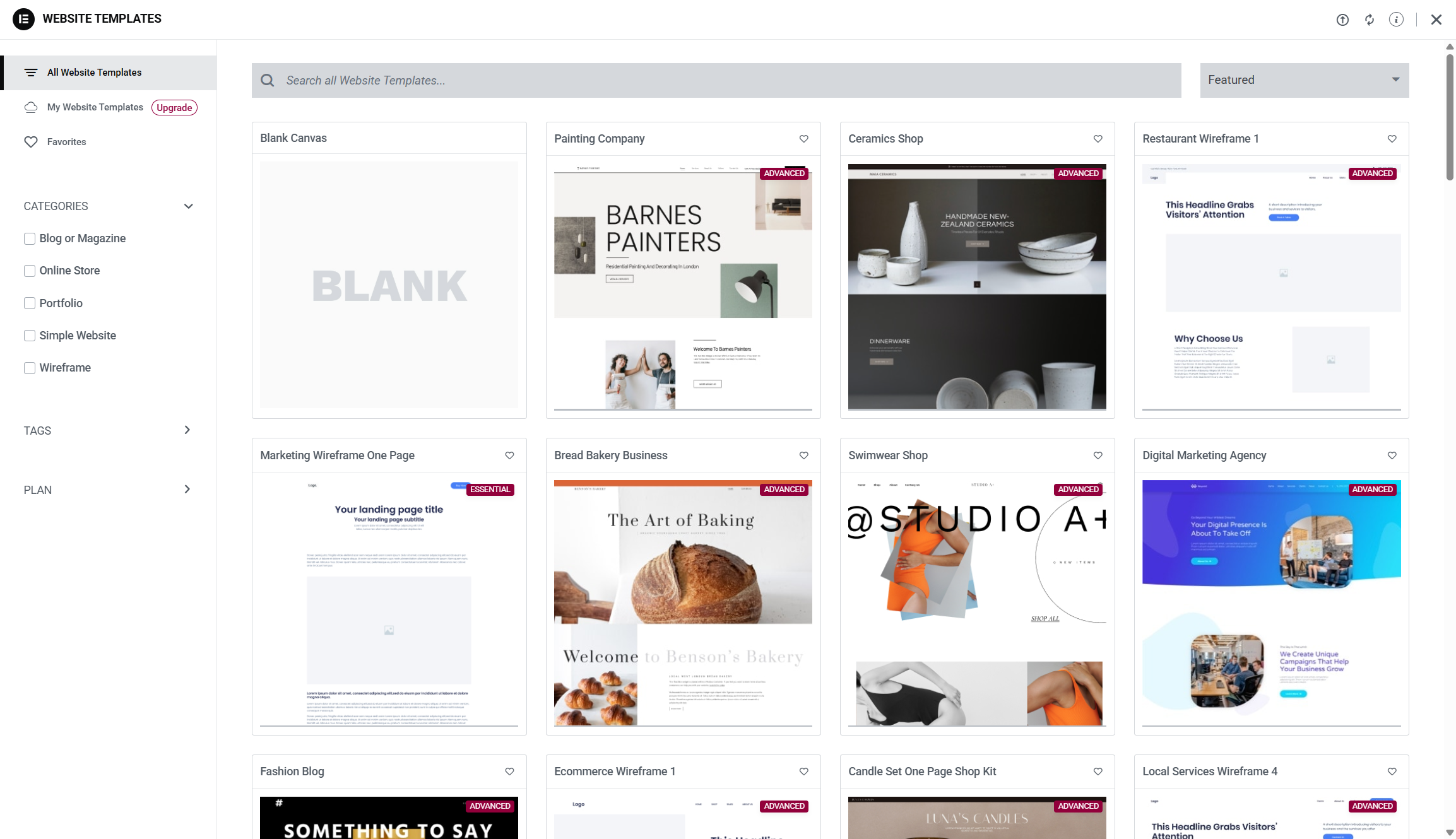
Next, I wanted to switch up my starting template.
I navigated to Templates > Website Templates in the WordPress admin. Elementor presented me with 100+ pre-made design kits. I could filter by category or search specific designs. A preview function also let me see layouts before importing.
I selected a simple business template by clicking the Apply button. I had the option to import either the entire template with all placeholder content, or only certain parts of it. It loaded instantly into my editor.
Step 3: Customizing a page
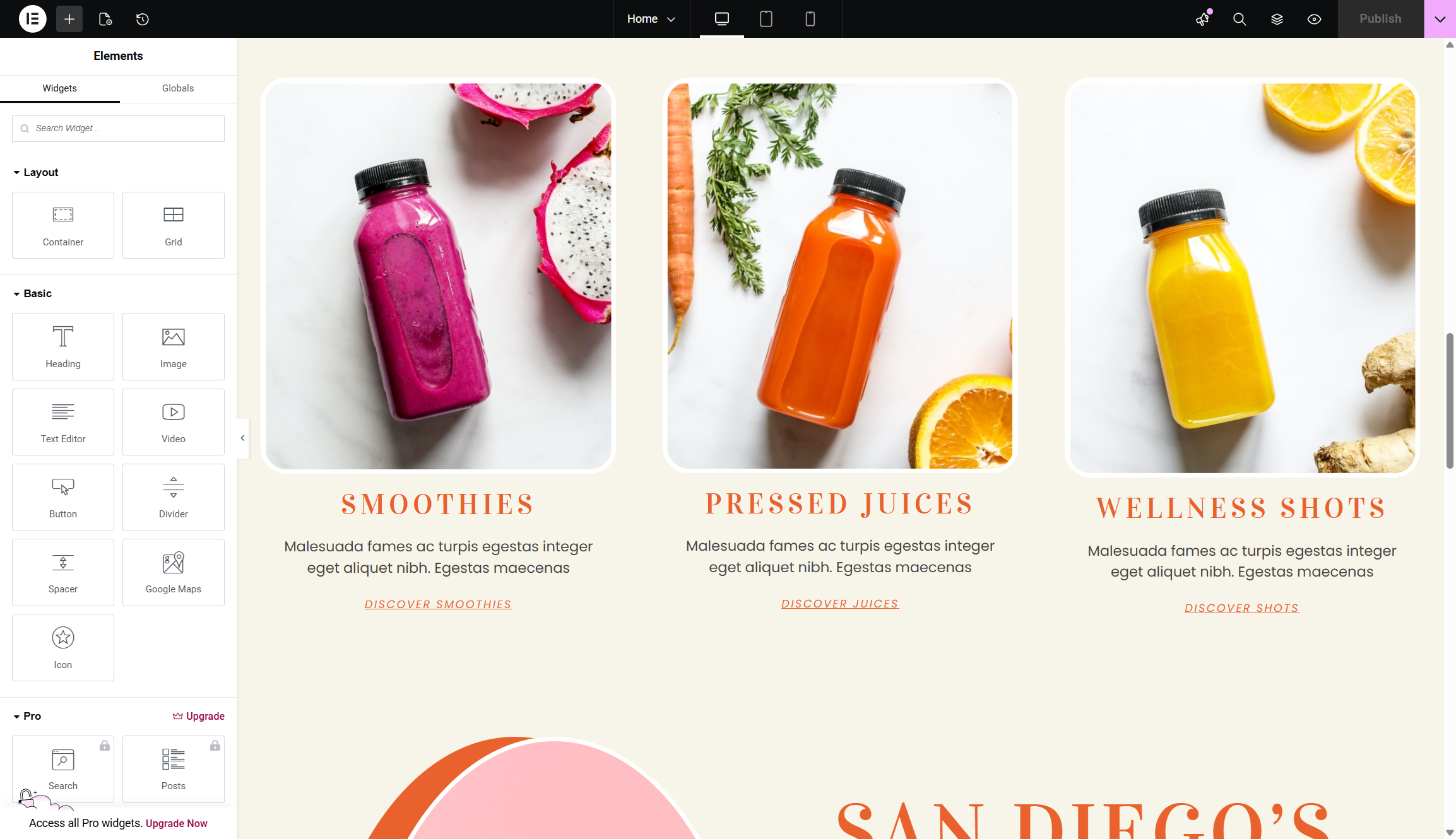
To customize my landing page, I navigated to the Pages tab in my WordPress dashboard and clicked on the “Edit with Elementor” option under the page I wanted to customize. This opened the page builder.
For each page, I could add sections and columns to create layouts. The drag-and-drop system felt seamless, with every change appearing instantly on screen.
Step 4: Adding widgets
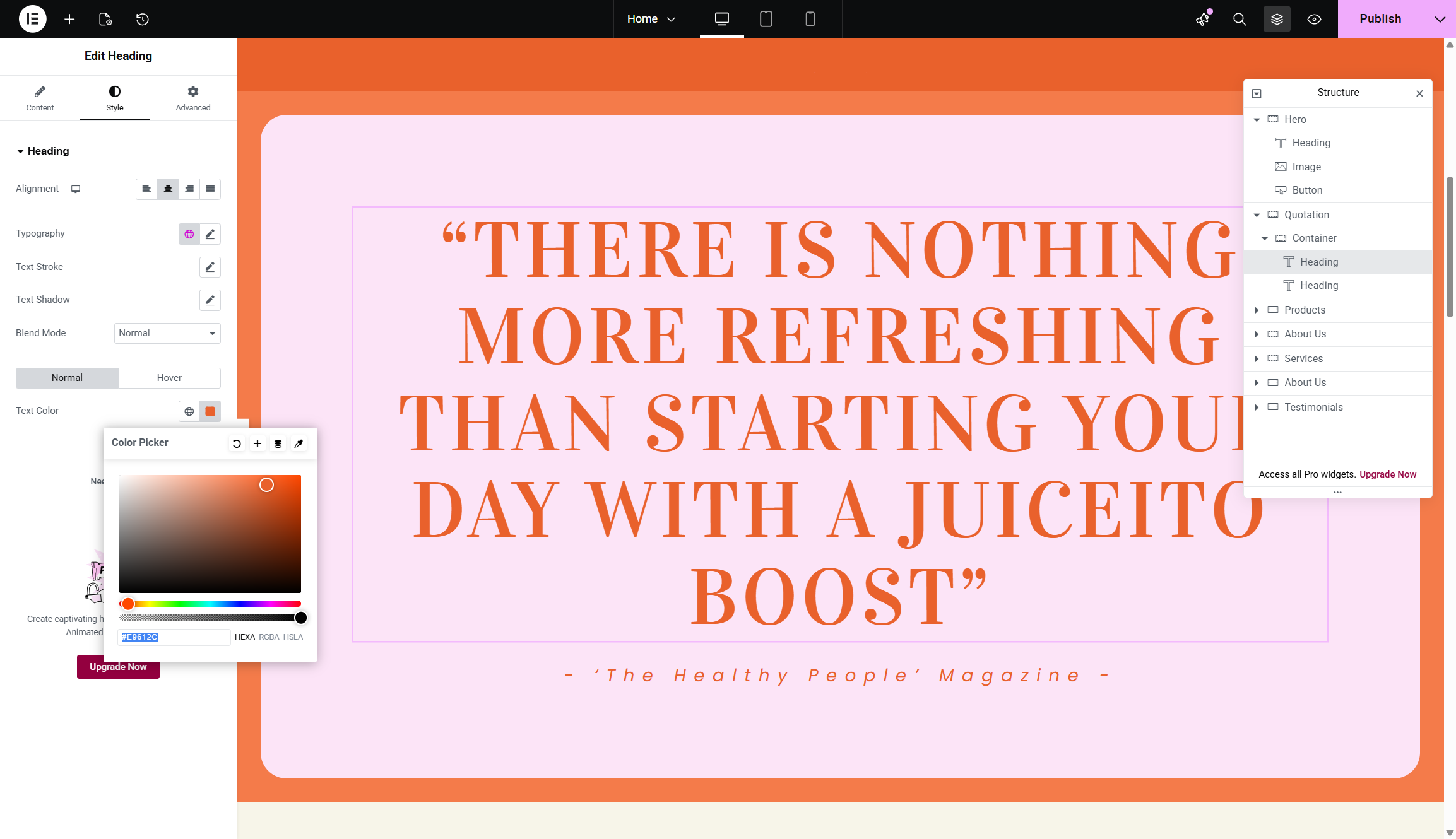
Elementor's widget panel was nested on my left.
I could drag a widget onto the page and drop it exactly where I wanted it. Clicking the widget opened customization options. Three tabs — Content, Style, and Advanced — organized all settings.
Elementor’s contextual settings adapted to whatever element I clicked. I adjusted fonts, colors, and spacing without touching any code.
Step 5: Publishing the site

I clicked "Publish" when satisfied with my design. My site went live immediately. Elementor's revision history was a nice addition, since it could revert to earlier designs anytime if something felt off.
A built-in caching system optimized my pages automatically. My test site loaded quickly, especially without installing many other plugins.
Elementor business tools
Elementor gives users access to the following business tools:
- Flexible landing page editor
- WooCommerce store builder
- Advanced form builder with integrations
- Roll-based access manager
Elementor delivers solid business functionality for ecommerce and lead generation. I liked the deep WooCommerce integration in particular. However, the CRM features felt underdeveloped compared to dedicated platforms.
Read more about Elementor's business tools ▼
Landing page editor
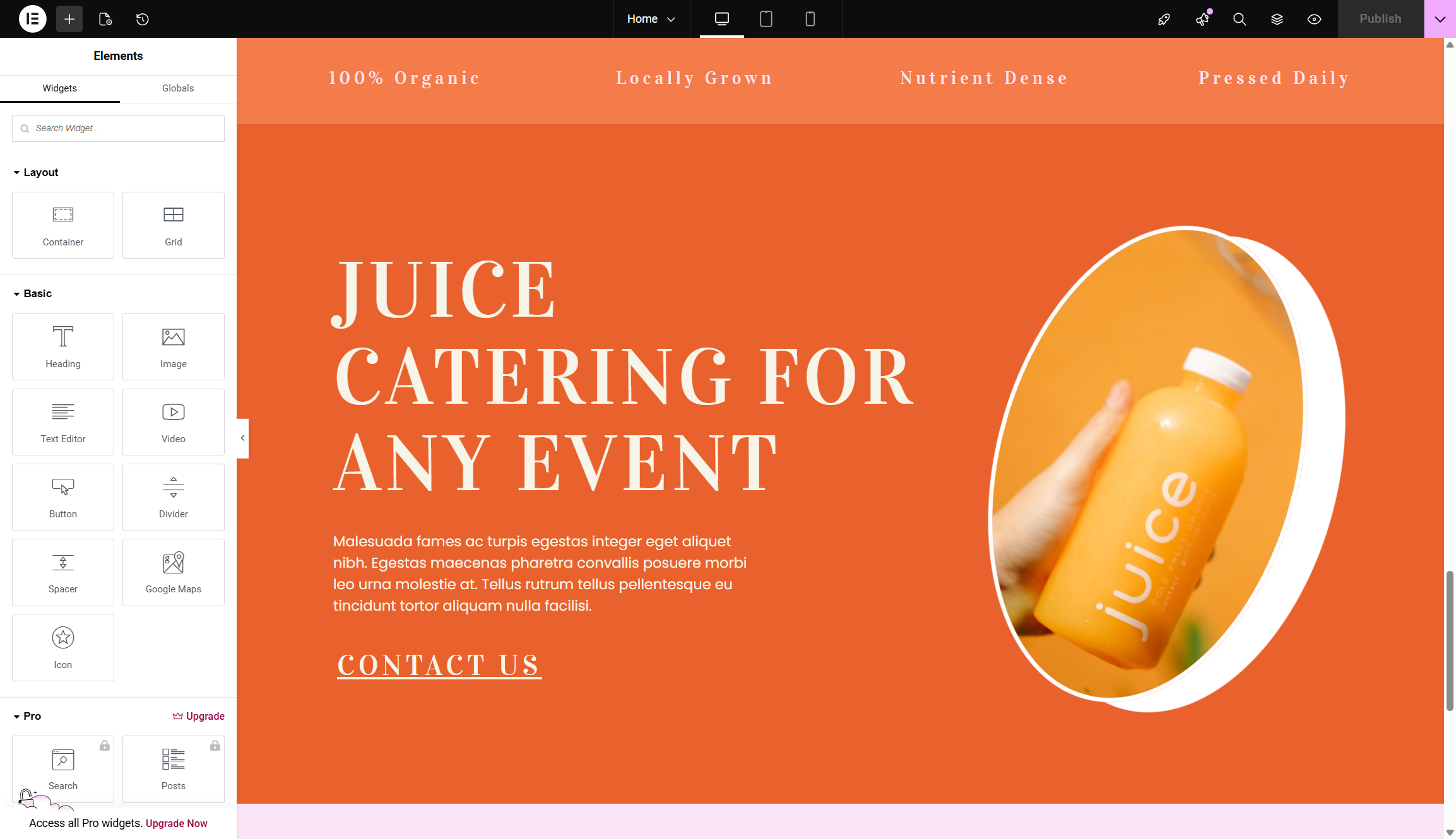
Building landing pages with Elementor felt straightforward. The template library provided conversion-focused designs ready for customization. I modified headlines, images, and call-to-action buttons within minutes.
The landing page templates integrated seamlessly with form widgets. I connected forms to email marketing platforms for automatic list building. Each template prioritized mobile responsiveness, which saved design time.
WooCommerce integration
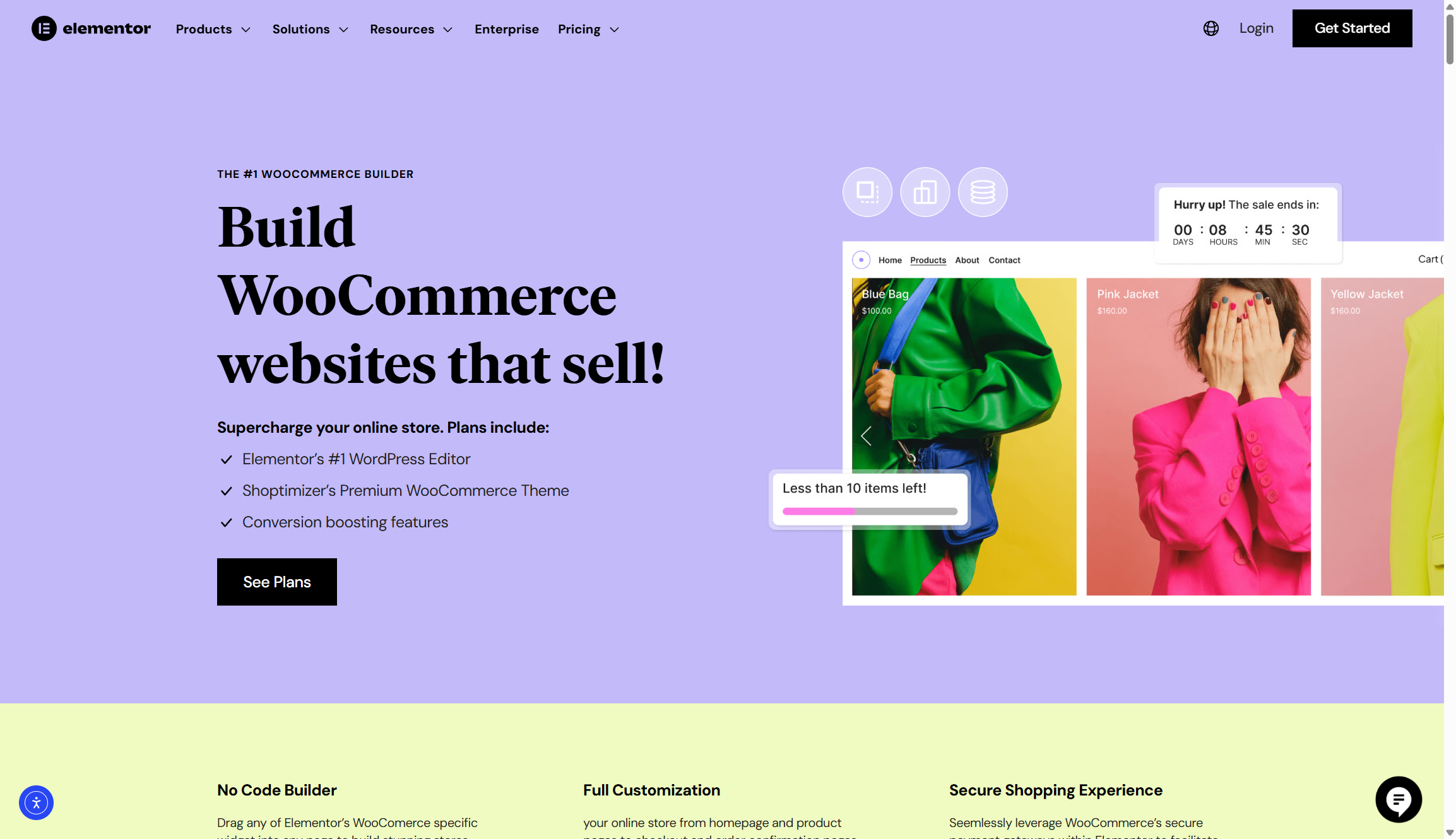
Elementor's premium WooCommerce integration lets you customize every aspect of your store, from product pages to checkout flows. Its visual editor made styling product grids and single product layouts effortless.
I could add WooCommerce-specific widgets like product meta, add-to-cart buttons, and customer ratings. It also integrates with popular payment gateways like Stripe and PayPal for direct purchases.
Form builder
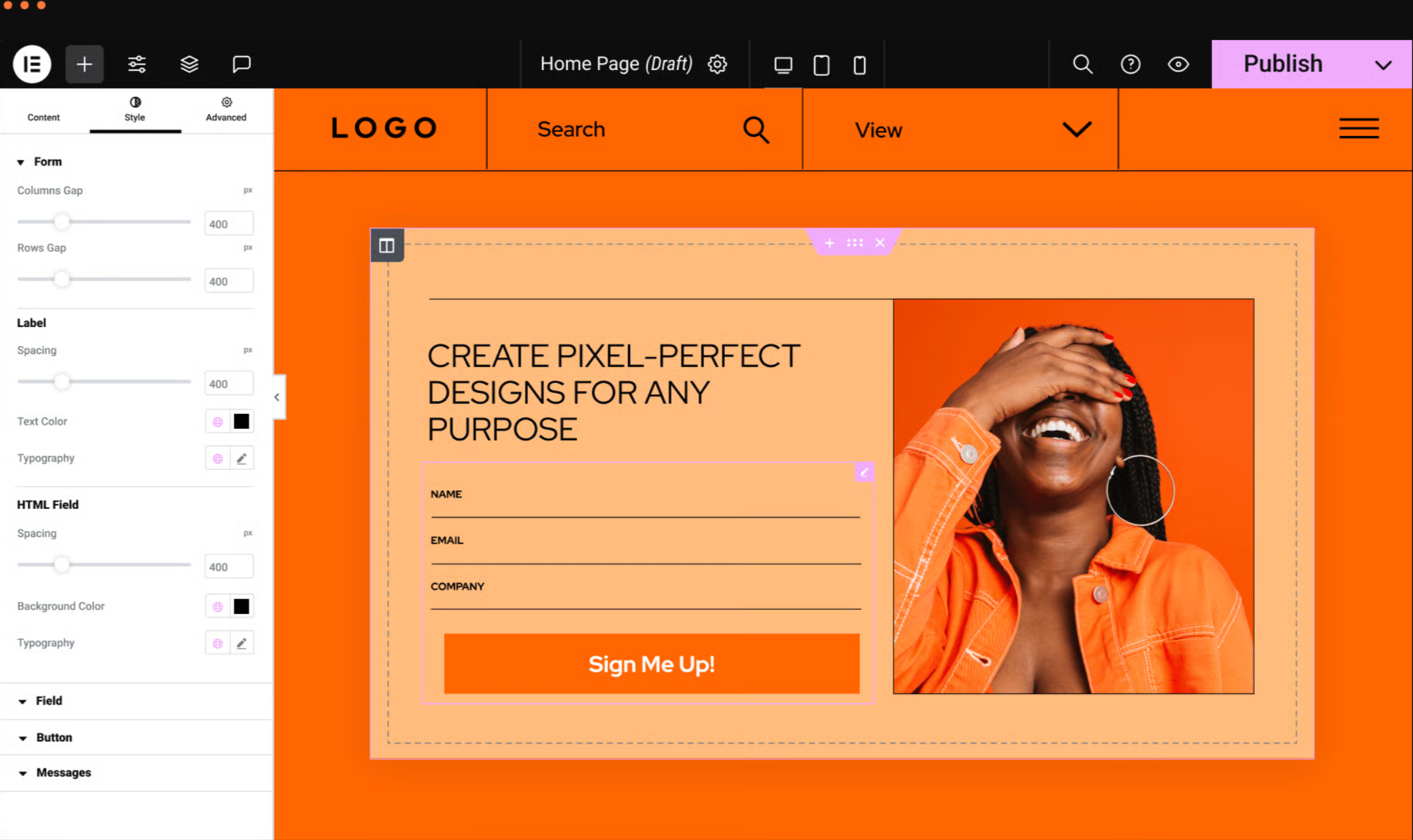
Creating forms felt easy with Elementor's form widget. I built contact, lead capture, and multi-step forms without any additional plugins. The form builder offered unlimited fields with full styling control.
I could also connect forms directly to Mailchimp, HubSpot, and ActiveCampaign. And the HoneyPot spam protection added security without any extra setup.
Role-based access settings
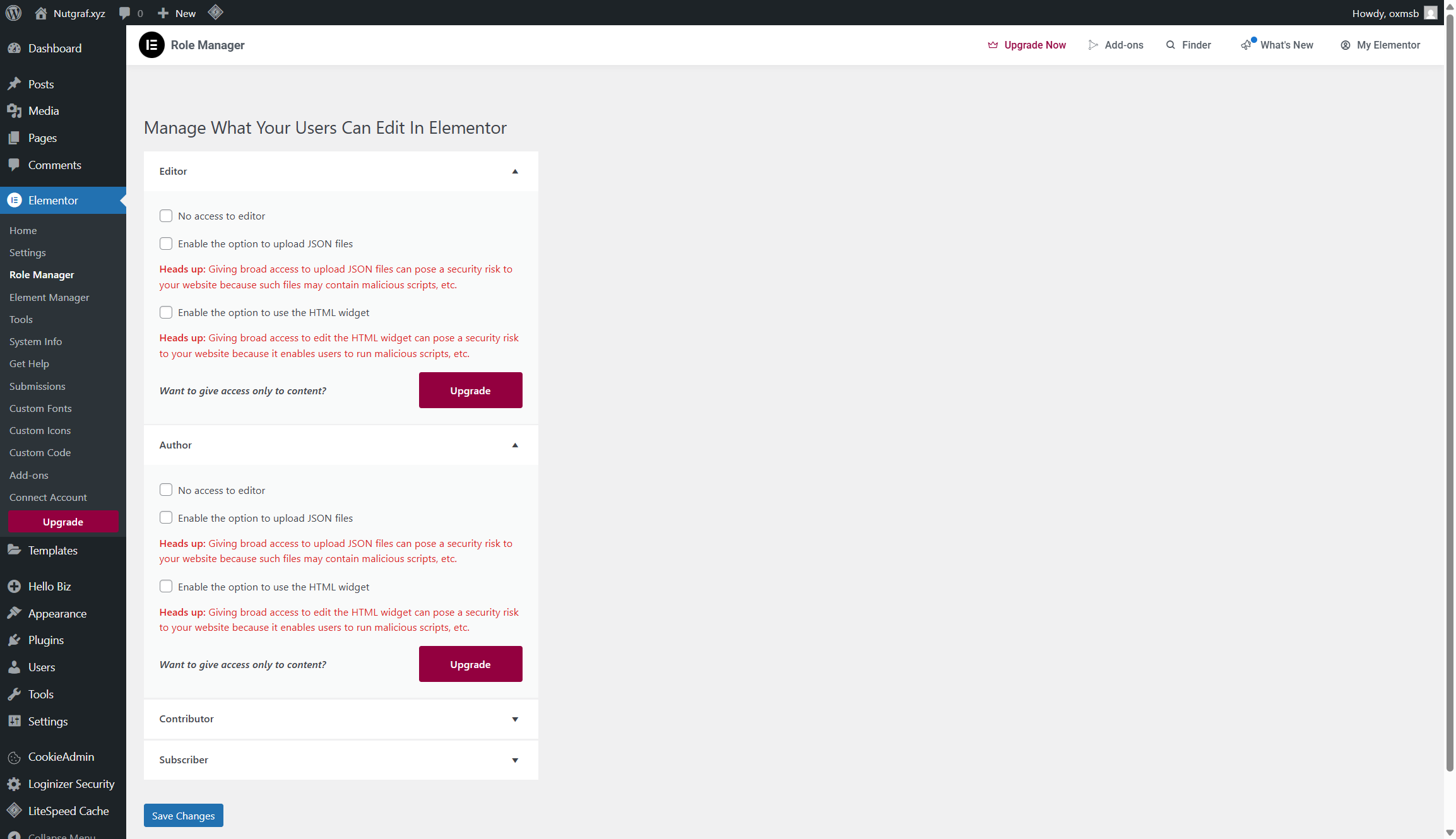
Elementor lets you control who accesses the editor and what they can modify. You navigate to Elementor > Role Manager in WordPress and configure permissions for each user role.
There are three main permission levels. "No access to editor" completely blocks users from opening Elementor. "Access to edit content only" allows users to modify existing content without adding or removing elements. Full access grants unlimited editing capabilities.
Version 3.19 has also added Element Manager integration, letting me customize which widgets appear for specific roles.
Elementor marketing tools
You can promote your business and website with Elementor’s marketing tools:
- Popup design with triggers
- CRM integrations for HubSpot, ActiveCampaign, etc.
- Email marketing integrations
- Call-to-action widgets
Elementor's marketing toolkit covers essential lead generation and conversion optimization. The popup builder and landing page features stood out during testing. Email marketing felt limited without third-party integrations, though.
Read more about Elementor's marketing tools ▼
Popups and notifications
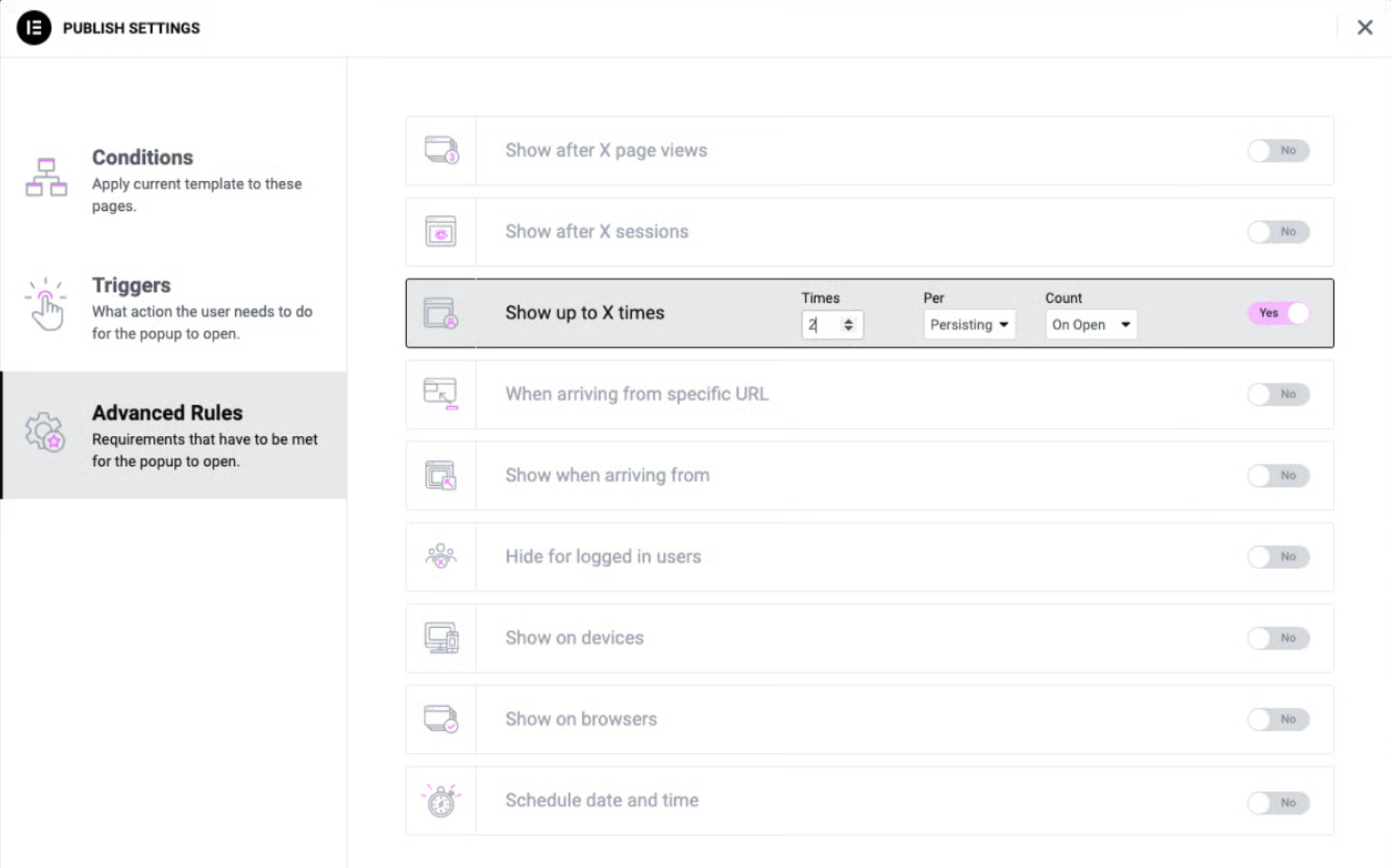
I could create several popup types using Elementor's Popup Builder. It supports email capture popups, notification bars, and two-step opt-ins. I enjoyed the visual editing experience, which matches the main page builder.
With display conditions, Elementor lets you have impressive targeting flexibility. I could design popups to trigger based on scroll depth, exit intent, inactivity, and specific page elements. I also tested a two-step opt-in popup combining a yes/no prompt with a follow-up form. It worked exactly as described.
CRM automation

I was able to set up connections to HubSpot and ActiveCampaign. Elementor's form submissions triggered automated workflows in both these platforms.
That said, setting up automation required technical knowledge. I had to look up their API documentation and learn Elementor’s webhook configurations. This might challenge non-technical users.
Email marketing

Elementor doesn't include built-in email marketing functionality.
Instead, it integrates with popular platforms like Mailchimp, SEND, and ActiveCampaign. I connected Mailchimp through the form widget settings.
Integration required API keys from Mailchimp. Once configured, captured leads automatically synced to my email lists. I also used Elementor's design tools to create branded signup forms matching my email campaigns.
CTA widgets
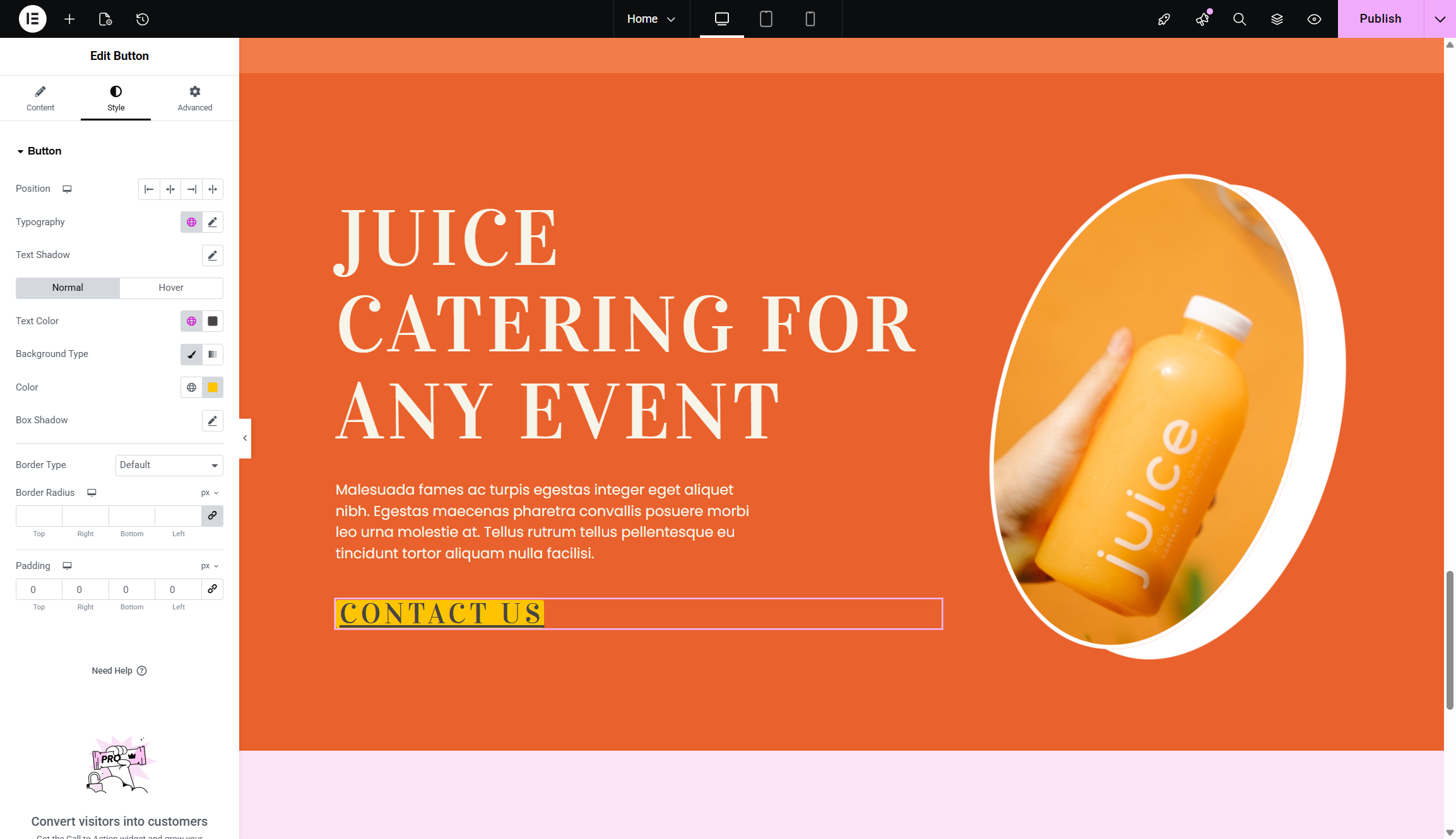
Elementor offered dedicated CTA widgets for marketing campaigns. I customized button styles, added icons, and set hover effects. The widgets supported internal links, external URLs, and popup triggers.
The pixel-perfect placement flexibility helps with conversion optimization. But if you want A/B testing, you'll need a third-party plugin for that.
Elementor support
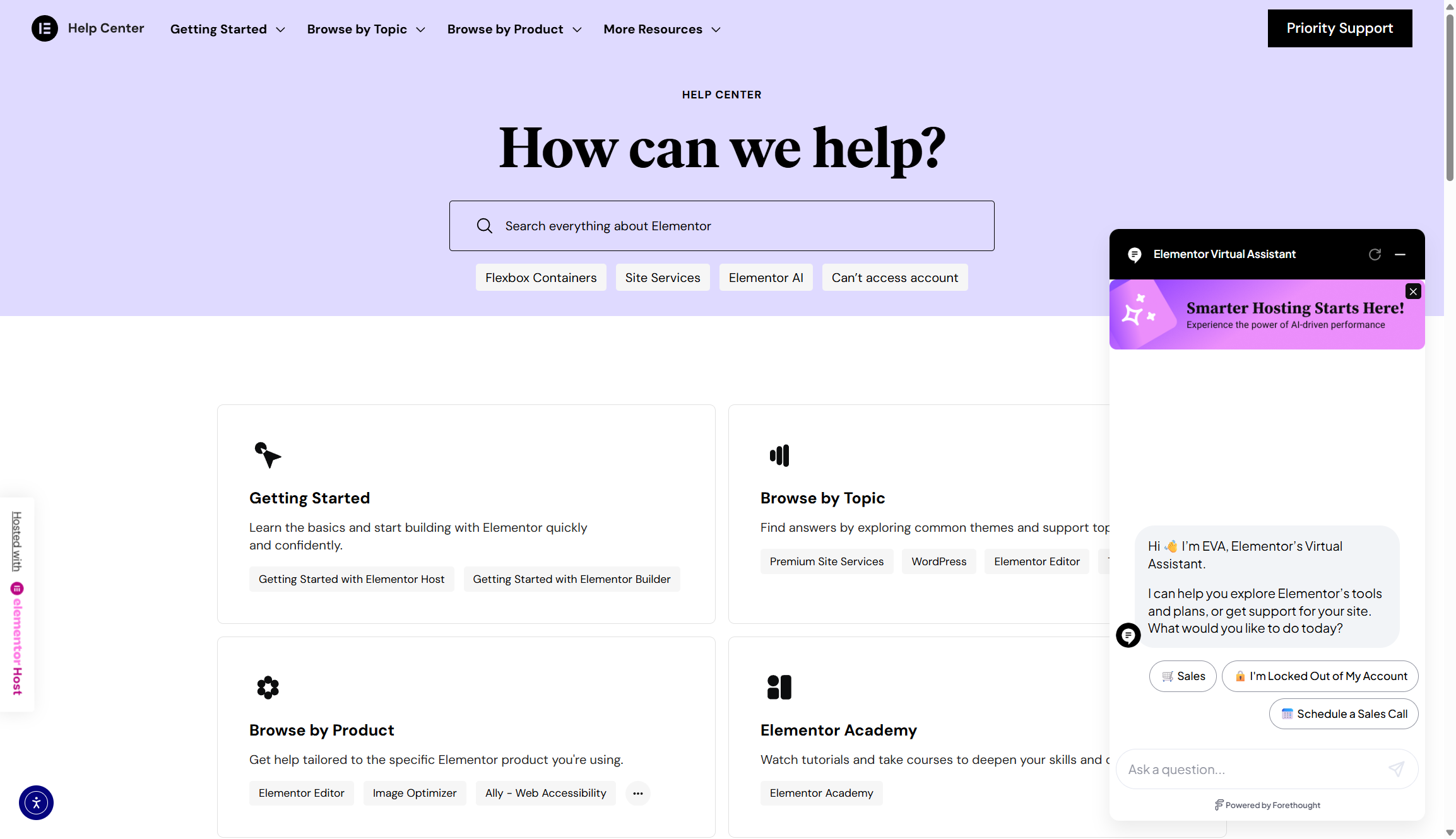
Elementor Pro users access official support through ticket submission and live chat. Free version users rely on community forums and documentation. Support operates Monday through Friday with varying response times based on plan tier.
I submitted a test support ticket during my review. The response came within 24 hours with a detailed troubleshooting guide. But the AI chatbot could answer basic questions instantly before escalating complex issues.
However, user sentiment reveals mixed experiences.
Reddit threads show frustration with renewal price increases and slow support responses. One user reported opening six tickets with minimal resolution. G2 reviews praise ease of use but note the learning curve. Capterra users appreciate constant updates but mention WooCommerce plugin compatibility issues.
Test results: Elementor
Attribute | Notes | Rating |
Value for money | Competitive pricing initially, but renewal rates increase significantly over time. Pro features justify the cost for agencies. | ★★★⯪☆ |
Ease of use | Intuitive drag-and-drop interface with visual editing. Learning curve exists due to extensive options. | ★★★★☆ |
Design | 100+ design kits provide exceptional design flexibility. Responsive controls offer granular customization. | ★★★★★ |
Business tools | Solid WooCommerce integration and form builder. Limited native analytics and CRM capabilities. | ★★★★☆ |
Marketing tools | Excellent popup builder and landing pages. Email marketing requires third-party integrations. | ★★★★☆ |
Support | Responsive ticket system for Pro users. Community sentiment reveals inconsistent experiences and price frustration. | ★★★☆☆ |
Competitor comparison: Elementor
Below we show you how Elementor stacks up against Divi and Beaver Builder:
Platform | Best for | Our overall rating | Free plan | Paid plans start at | Ease of use | Support |
Elementor | WordPress flexibility | ★★★★☆ | Yes | $4.92/month | ★★★★☆ | Live chat, tickets, community |
Divi Builder | Design variety | ★★★★☆ | No | $19.00/month | ★★★★☆ | Email, community forum |
Beaver Builder | Performance optimization | ★★★★☆ | Yes | $9.92/month | ★★★⯪☆ | Email, forums |
How we tested the Elementor website builder
Every website builder review on Techradar is based on hands-on testing. I installed Elementor on multiple WordPress sites, built test pages across different niches, and measured performance metrics. Each feature was scrutinized through practical application, not just documentation review.
We've been reviewing business software since 2012 at TechRadar Pro. For complete details on our evaluation process, read about how we test website builders.
Elementor review: FAQs
Is Elementor free to use?
Yes, Elementor offers a free version with basic page-building capabilities.
You get 40+ widgets, 30+ templates, and the drag-and-drop editor. However, advanced features like Theme Builder, WooCommerce Builder, and popup builder require Elementor Pro. The free version limits you to content editing within existing theme structures.
How do I install Elementor on WordPress?
Navigate to your WordPress Dashboard, click Plugins > Add New, search for "Elementor," then click Install and Activate. For Elementor Pro, download the plugin zip file from your Elementor account at my.elementor.com, upload it through WordPress Dashboard > Plugins > Upload Plugin, then activate your license key.
What's the difference between Elementor and Elementor Pro?
Elementor Pro includes 100+ widgets and templates versus 40+ in the free version, plus Theme Builder for headers/footers, WooCommerce Builder, popup builder, form integrations, and priority support. The free version limits customization to page content only, while Pro controls every site element including 404 pages.
Can I speed up my Elementor website?
Yes, activate Elementor's performance experiments including Optimized DOM Output, Improved Asset Loading, and Improved CSS Loading under Settings > Features.
You can also optimize images, enable caching plugins like WP Rocket, minimize unnecessary plugins, and consider a CDN. Reduce sections, widgets, and columns in your designs.
Does Elementor work with all WordPress themes?
Elementor works with most WordPress themes, though compatibility varies.For best results, use themes specifically built for Elementor or the Elementor Hello theme.
The Theme Builder feature in Elementor Pro lets you override theme templates entirely, reducing compatibility issues. Some themes may conflict with Elementor's styling.

Ritoban Mukherjee is a tech and innovations journalist from West Bengal, India. These days, most of his work revolves around B2B software, such as AI website builders, VoIP platforms, and CRMs, among other things. He has also been published on Tom's Guide, Creative Bloq, IT Pro, Gizmodo, Quartz, and Mental Floss.
- Owain WilliamsB2B Editor, Website Builders & CRM
You must confirm your public display name before commenting
Please logout and then login again, you will then be prompted to enter your display name.
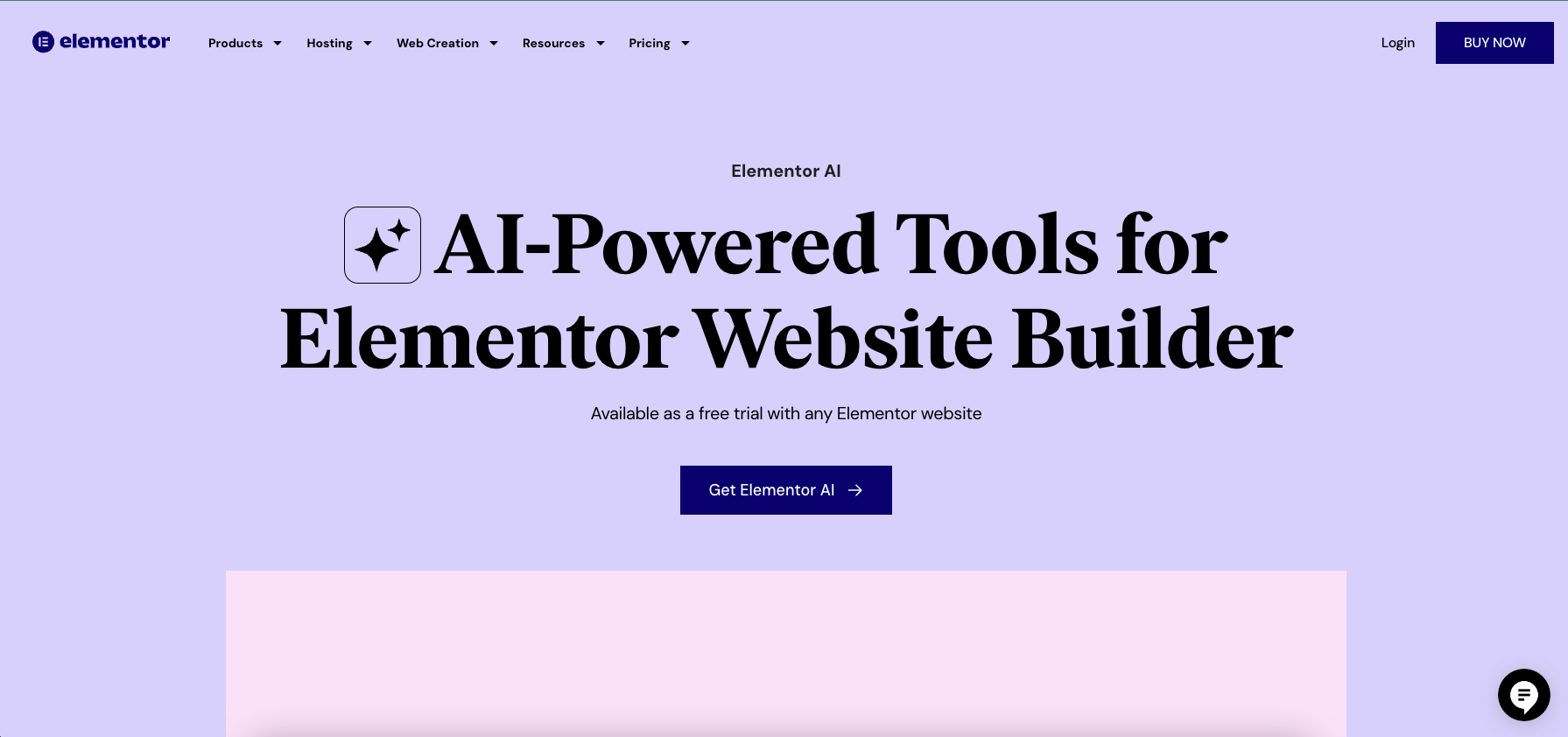
![Elementor [Free] Elementor [Free]](https://cdn.mos.cms.futurecdn.net/9SKUtgeCY8iM2MjxNC6CgV-200-80.jpg.webp)